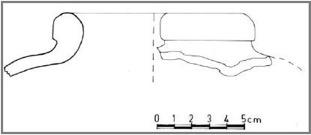Phoenician Amphorae
(Phoenician Age)
The term "amphora" indicates a terracotta container with a tapered or globular shape, provided with two handles, used in antiquity to transport liquid (wine, oil) or solid (wheat or other grains) foodstuffs.
A fragment of Phoenician amphora was found during the excavations carried out by the Archaeological Heritage department in Posada, which consisted of part of the rim, neck and shoulder (fig. 1); it is characterised by a compact mixture and by a surface with a light pink film. This fragment should probably be connected to the Ramon T-3.1.1.2. type, identified as central Mediterranean amphorae produced in Motya and Carthage and their surrounding areas, dating from the second half of the eighth century B.C. and much of the seventh century B.C. (figs. 2-3-4).
This type of amphora was probably intended to contain and transport wine.




Bibliografia
- J. RAMON TORRES, Las ánforas fenicio-púnicas del Mediterráneo central y occidental, Barcelona 1995.
- A. SANCIU, Fenici lungo la costa orientale sarda. Nuove acquisizioni. Fasti On Line Documents & Research 174, 2010.
- A. SANCIU, Nuove testimonianze di età punica da Posada e dalla Sardegna centro-orientale. Sardinia, Corsica et Baleares Antiquae, IX, pp. 51-58.
- A. SANCIU, Posada. Centro storico. Recupero di materiali archeologici. Erentzias. Rivista della Soprintendenza per i Beni Archeologici per le province di Sassari e Nuoro, I, pp. 376-377.
- A. SANCIU, Nuove testimonianze d’età fenicia e punica dalla costa centro-orientale sarda. ArcheoArte. Rivista elettronica di Archeologia e Arte, Supplemento 2012 al numero 1, pp. 167-182.
- M.P. TOTI, Le anfore fenicie e puniche della collezione Whitaker (Museo G. Whitaker, Isola di Mozia), in Atti delle Quarte Giornate Internazionali di Studi sull’area Elima (Erice, 1-4 dicembre 2000), III, Pisa 2003, pp. 1203-1214, tav. CCIV, figg. 1-2.

 VR
VR